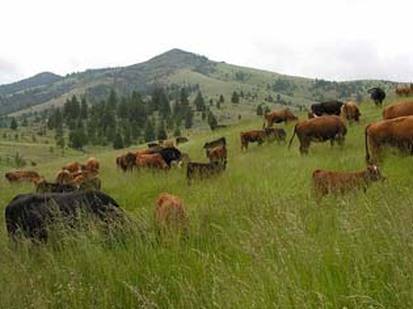
I love when you are talking with someone and you unexpectedly learn something about them you never knew. Yesterday, I was talking to one of my former clients with the Wild & Scenic Film Festival. Up till then, Mary was just the executive director of the organization hosting the tour venue in Salmon, ID. Now, I know her as a cattle rancher growing pasture-raised beef. I picked her brain for about 30-minutes...
Mary and her husband, Lowell, are part of a 120-ranch cooperative called Country Natural Beef. It is one of the nation's leaders in "natural" beef production and is widely available in most Whole Foods in the western United States as well as several, independent, food stores. Find a store near you, click here. Country Natural Beef ranchers truly own the meaning of "natural." Where otherwise, the term has been sadly diluted by giant food marketers trying to capitalize on this word's wholesome disposition. Ranchers of Country Natural Beef (CNB) collectively agree on a set of guiding principles which ensure all members raise their cattle humanely - start to finish, using no hormones or antibiotics and with respect to the environment. A big hurdle for most beef producers is finding a feedyard and slaughterhouse where their cattle can live out their lives with the same core values in which they were raised. As a cooperative, CNB can pull their buying power and select the best finishing practices for their cattle. Most cattle get sold to a feedlot at 9-months of age. CNB cows stay in pasture until they are 14-18 months reducing their feedyard time to only 90-days. During those final days, conditions are clean and spacious with access to fresh water and a balanced diet of grain, alfalfa, hay, potatoes and peas versus corn and soy. The night before they are harvested, they enjoy a good nights rest and are put down with as little stress as possible extending them the honor they deserve for the life they are offering.
Back on the farm, the average acreage for one CNB cow and its calf is 70 acres of grassy fields. It is just one indication of how happy these lives are. And here is where Country Natural Beef misses the "organic" mark...In summer, cattle graze on miles of Forest Service land in the high mountains. Mary and Lowell's cattle splendor on 200,000 acres making it nearly impossible to verify that much acreage for organic certification. With certification comes compromise. And Country Natural Beef isn't willing to compromise by limiting their cattle's range. Only the best!
Parting Note...While on my way to a bike ride this morning, I was listening to a NPR report about the salmonella outbreak in Cargill's ground turkey. It was interesting to learn that antibiotics served in conventional ranching are not prescribed as much to ward off disease and keep our food safe as they are to help the cows grow faster. Yikes! Why so many food born disease then?...Strains of salmonella, like Heidelberg in the Cargill case, are becoming resistance to antibiotics. But here's the real scary part...proponents of continued antibiotic use suggest that livestock take one type of antibiotic and humans another so people don't become immune to antibiotics when we need them. Am I the only one who thinks this sounds crazy? How about we look at the way we are raising the cattle instead of slapping band-aids?

 RSS Feed
RSS Feed
